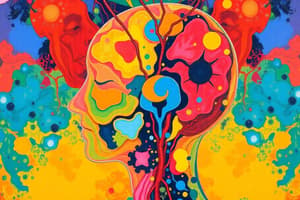Podcast
Questions and Answers
What is the main function of rods in the retina?
What is the main function of rods in the retina?
- To convert sound waves into neural impulses
- To process balance information
- To facilitate night vision (correct)
- To detect color in bright light
What role do taste buds on the tongue primarily serve?
What role do taste buds on the tongue primarily serve?
- Converting sound into neural information
- Detecting balance and spatial orientation
- Identifying chemical substances in food (correct)
- Filtering visual stimuli for brightness analysis
Which sensory system relies on tiny hair cells for signal conversion?
Which sensory system relies on tiny hair cells for signal conversion?
- Vision
- Olfaction
- Hearing (correct)
- Vestibular sense
What does sensory reduction involve?
What does sensory reduction involve?
Which term describes the smallest change in a stimulus that can be detected?
Which term describes the smallest change in a stimulus that can be detected?
Where are the olfactory receptors located?
Where are the olfactory receptors located?
What is adaptation in sensory processing?
What is adaptation in sensory processing?
What is the primary role of kinesthesis?
What is the primary role of kinesthesis?
What concept does psychophysics study?
What concept does psychophysics study?
Which of the following is NOT a part of the sensory systems listed?
Which of the following is NOT a part of the sensory systems listed?
Flashcards are hidden until you start studying
Study Notes
Sensation
- It's the process of receiving, converting, and transmitting sensory information about the outside world.
Sensory Systems
- Vision: Visual receptors located on the retina, rods are for night vision and cones for color vision.
- Hearing: Audition occurs via sound waves, vibrations in air pressure caused by objects. Receptors in the inner ear (cochlea) convert sound energy to neural impulses.
- Smell (Olfaction): Receptors located at the top of the nasal cavity.
- Taste (Gustation): Taste buds on the tongue. Four basic tastes: sweet, salty, sour, and bitter.
- Vestibular Sense (Balance): Receptors are in the inner ear.
- Kinethesis (Body Movement): Receptors in muscles, joints, and tendons.
- Touch: Skin detects pressure, temperature, and pain.
Processing
- Sensory Reduction: Filtering and analyzing sensations before sending messages to the brain.
- Transduction: Converting receptor energy into neural impulses.
- Adaptation: Decreased sensory response to continuous stimuli.
Psychophysics
- The study of the relationship between the physical properties of stimuli and a person's experience.
- Absolute Threshold: The minimum amount of energy we can detect.
- Difference Threshold (JND): The smallest change in a stimulus we can detect.
Perception
- A constructive process where we go beyond presented stimuli to create meaning.
Studying That Suits You
Use AI to generate personalized quizzes and flashcards to suit your learning preferences.




